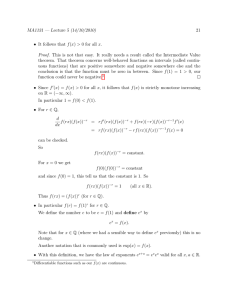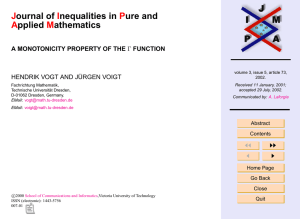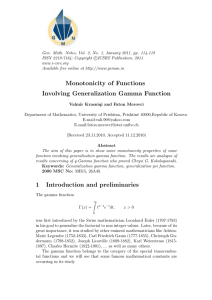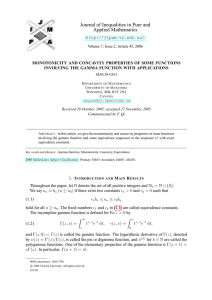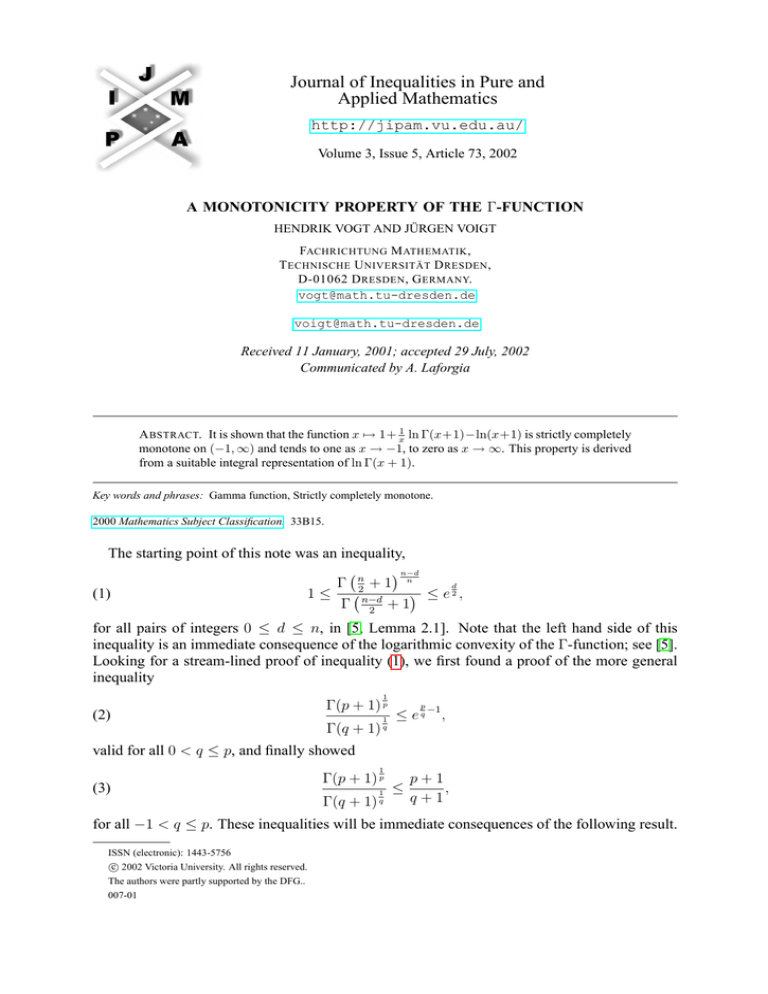
Journal of Inequalities in Pure and
Applied Mathematics
http://jipam.vu.edu.au/
Volume 3, Issue 5, Article 73, 2002
A MONOTONICITY PROPERTY OF THE Γ-FUNCTION
HENDRIK VOGT AND JÜRGEN VOIGT
FACHRICHTUNG M ATHEMATIK ,
T ECHNISCHE U NIVERSITÄT D RESDEN ,
D-01062 D RESDEN , G ERMANY.
vogt@math.tu-dresden.de
voigt@math.tu-dresden.de
Received 11 January, 2001; accepted 29 July, 2002
Communicated by A. Laforgia
A BSTRACT. It is shown that the function x 7→ 1+ x1 ln Γ(x+1)−ln(x+1) is strictly completely
monotone on (−1, ∞) and tends to one as x → −1, to zero as x → ∞. This property is derived
from a suitable integral representation of ln Γ(x + 1).
Key words and phrases: Gamma function, Strictly completely monotone.
2000 Mathematics Subject Classification. 33B15.
The starting point of this note was an inequality,
n−d
Γ n2 + 1 n
d
≤ e2 ,
(1)
1≤
n−d
Γ 2 +1
for all pairs of integers 0 ≤ d ≤ n, in [5, Lemma 2.1]. Note that the left hand side of this
inequality is an immediate consequence of the logarithmic convexity of the Γ-function; see [5].
Looking for a stream-lined proof of inequality (1), we first found a proof of the more general
inequality
1
(2)
Γ(p + 1) p
Γ(q + 1)
1
q
p
≤ e q −1 ,
valid for all 0 < q ≤ p, and finally showed
1
(3)
Γ(p + 1) p
Γ(q + 1)
1
q
≤
p+1
,
q+1
for all −1 < q ≤ p. These inequalities will be immediate consequences of the following result.
ISSN (electronic): 1443-5756
c 2002 Victoria University. All rights reserved.
The authors were partly supported by the DFG..
007-01
2
H ENDRIK VOGT AND J ÜRGEN VOIGT
Theorem 1. The function f (x) := 1 + x1 ln Γ(x + 1) − ln(x + 1) is strictly completely monotone
on (−1, ∞),
lim f (x) = 1,
x→−1
lim f (x) = 0,
x→∞
f (0) = lim f (x) = 1 − γ.
x→0
(Here, γ is the Euler-Mascheroni constant, and strictly completely monotone means
(−1)n f (n) (x) > 0 for all x ∈ (−1, ∞), n ∈ N0 ).
Proof. The main ingredient of the proof is the integral representation
Z ∞
1
1
1
− t
e−t (1 − e−xt ) dt,
ln Γ(x + 1) = x ln(x + 1) − x +
t e −1
t
0
which is an immediate consequence of [6, formula 1.9 (2) (p. 21)] and [6, formula 1.7.2 (18)
(p. 17)]. We obtain
Z ∞
1
1
1
− t
e−t (1 − e−xt ) dt.
f (x) =
t e −1
xt
0
The function
1
g(y) := (1 − e−y ) =
y
Z
1
e−sy ds
0
is strictly completely monotone on R. Since 1t − et1−1 > 0 for all t > 0, we conclude that f is
strictly completely monotone. As y → ∞, g(y) tends to zero, and hence limx→∞ f (x) = 0.
The definition of f shows limx→0 f (x) = 1 + ψ(1) = 1 − γ; cf. [6, formula 1.7 (4) (p. 15)].
Finally,
1
lim f (x) = 1 + lim
ln Γ(x + 2) − ln(x + 1) − ln(x + 1) = 1.
x→−1
x→−1
x
Corollary 2. Inequalities (3), (2) and (1) are valid for the indicated ranges.
Proof. Inequality (3) is just a reformulation of the monotonicity of the function f from Theorem 1. Continuing (3) to the right,
p
p+1
p
≤ ≤ e q −1
q+1
q
we obtain (2). Setting q =
n−d
,
2
p=
n
2
we get (1).
(0 < q ≤ p),
Remark 3.
ξ
1
(a) In [4] it was shown that the function ξ 7→ ξ Γ 1 + ξ
is increasing on (0, ∞). This
fact follows immediately from our Theorem 1, because of
1
1
1
ln
Γ(x + 1) x + 1 = − ln x + Γ(x + 1) + 1 = ln(x + 1) − ln x + f (x).
x
x
(In fact, the latter function even is strictly completely monotone as well.)
(b) For other recent results on (complete) monotonicity properties of the Γ-function we
refer to [1, 2, 3].
J. Inequal. Pure and Appl. Math., 3(5) Art. 73, 2002
http://jipam.vu.edu.au/
A M ONOTONICITY P ROPERTY OF THE Γ- FUNCTION
3
R EFERENCES
[1] H. ALZER, On some inequalities for the gamma and psi functions, Math. Comp., 66(217) (1997),
373–389.
[2] G. D. ANDERSON AND S.-L. QIU, A monotoneity property of the gamma function, Proc. Amer.
Math. Soc., 125(11) (1997), 3355–3362.
[3] Á. ELBERT AND A. LAFORGIA, On some properties of the gamma function, Proc. Amer. Math.
Soc., 128(9) (2000), 2667–2673.
[4] D. KERSHAW AND A. LAFORGIA, Monotonicity results for the gamma function, Atti Accad. Sci.
Torino, Cl. Sci. Fis. Mat. Natur., 119(3-4) (1985), 127–133.
[5] A. KOLDOBSKY AND M. LIFSHITS, Average volume of sections of star bodies, In: Geometric
Aspects of Functional Analysis, V. D. Milman and G. Schechtmann (eds.), Lect. Notes Math., 1745,
Springer, Berlin, 2000, 119–146.
[6] A. ERDÉLYI, W. MAGNUS, F. OBERHETTINGER AND F. TRICOMI, Higher Trancscendental
Functions, McGraw-Hill Book Company, New York-Toronto-London, 1953.
J. Inequal. Pure and Appl. Math., 3(5) Art. 73, 2002
http://jipam.vu.edu.au/

